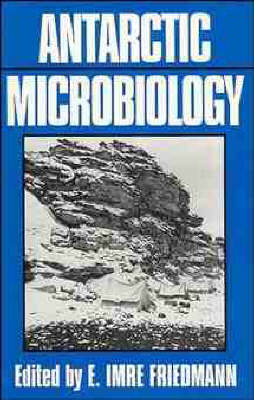
Antarctic Microbiology
Seiten
1993
John Wiley & Sons Inc (Verlag)
978-0-471-50776-5 (ISBN)
John Wiley & Sons Inc (Verlag)
978-0-471-50776-5 (ISBN)
- Titel ist leider vergriffen;
keine Neuauflage - Artikel merken
The entire ecosystem of the Antarctic continent and its surrounding seas is based primarily on micro-organisms. This volume records the diversity of Antarctic prokaryotes, algae, fungi and protozoa, and their marine, freshwater and terrestrial environments.
Antarctic Microbiology The extreme climate of Antarctica - its sub-zero temperatures, low humidity, high winds, and extended light and dark periods - has limited scientists in their search for information on microbial communities there and in the surrounding oceans. Most early microbiological research was descriptive and focused on the interactions of microbial communities with physical and chemical parameters. Today, thanks to enormous improvements in technology and logistics, microbiologists can study the functional processes of microbial communities and their biological interactions. Microbiological research in Antarctica is particularly relevant in light of today's discussions on global climate change. This volume offers an account of the microbial habitats and communities that play significant roles in the ecosystem of the Antarctic continent. Antarctic Microbiology demonstrates the explosion of new and exciting research into microbial communities, physiological rate processes, and adaptation of species at the biochemical and molecular level.
This text presents new information on: sea-ice microbial processes associated with the pack ice and the ocean photosynthesis, physiology, and adaptation of cryptoendolithic communities in sandstone formations biogeochemical cycling of carbon and nitrogen in unique lake systems in the dry valleys the development of microbial communities in volcanically heated soils the possible existence of ancient microbes in glacial ice biogeochemical cycling of elements in the marine ecosystem around Antarctica. Written by an international group of experts, Antarctic Microbiology will be of interest to all microbiologists and ecologists who study the diversity of microorganisms and their marine, freshwater, and terrestrial environments.
Antarctic Microbiology The extreme climate of Antarctica - its sub-zero temperatures, low humidity, high winds, and extended light and dark periods - has limited scientists in their search for information on microbial communities there and in the surrounding oceans. Most early microbiological research was descriptive and focused on the interactions of microbial communities with physical and chemical parameters. Today, thanks to enormous improvements in technology and logistics, microbiologists can study the functional processes of microbial communities and their biological interactions. Microbiological research in Antarctica is particularly relevant in light of today's discussions on global climate change. This volume offers an account of the microbial habitats and communities that play significant roles in the ecosystem of the Antarctic continent. Antarctic Microbiology demonstrates the explosion of new and exciting research into microbial communities, physiological rate processes, and adaptation of species at the biochemical and molecular level.
This text presents new information on: sea-ice microbial processes associated with the pack ice and the ocean photosynthesis, physiology, and adaptation of cryptoendolithic communities in sandstone formations biogeochemical cycling of carbon and nitrogen in unique lake systems in the dry valleys the development of microbial communities in volcanically heated soils the possible existence of ancient microbes in glacial ice biogeochemical cycling of elements in the marine ecosystem around Antarctica. Written by an international group of experts, Antarctic Microbiology will be of interest to all microbiologists and ecologists who study the diversity of microorganisms and their marine, freshwater, and terrestrial environments.
Partial table of contents:; MARINE ENVIRONMENTS; Phytoplankton (S. El-Sayed & G. Fryxell); Microorganisms in Antarctic Sea Ice (A. Palmisano & D. Garrison); Nearshore Benthic Marine Sediments (D. White, et al.); TERRESTRIAL AND FRESHWATER ENVIRONMENTS; The Microbiology of Antarctic Soils (H. Vishniac); Soils Heated by Volcanism (P. Broady); Microbial Communities and Processes in Antarctic Flowing Waters (W. Vincent, et al.); OTHER TOPICS; Human Infectious Diseases (H. Muchmore, et al.); Relevance of Antarctic Microbial Ecosystems to Exobiology (C. McKay); Protection of Antarctic Microbial Habitats (S. Draggan); Index.
| Erscheint lt. Verlag | 18.6.1993 |
|---|---|
| Reihe/Serie | Ecological & Applied Microbiology |
| Zusatzinfo | Ill. |
| Verlagsort | New York |
| Sprache | englisch |
| Maße | 157 x 235 mm |
| Gewicht | 1191 g |
| Themenwelt | Naturwissenschaften ► Biologie ► Limnologie / Meeresbiologie |
| Naturwissenschaften ► Biologie ► Mikrobiologie / Immunologie | |
| ISBN-10 | 0-471-50776-8 / 0471507768 |
| ISBN-13 | 978-0-471-50776-5 / 9780471507765 |
| Zustand | Neuware |
| Haben Sie eine Frage zum Produkt? |
Mehr entdecken
aus dem Bereich
aus dem Bereich
Naturerfahrungen zwischen Quelle, See und Wildfluss
Buch | Hardcover (2024)
Verlag Anton Pustet Salzburg
30,00 €
Buch | Hardcover (2022)
National Geographic Deutschland (Verlag)
39,99 €


